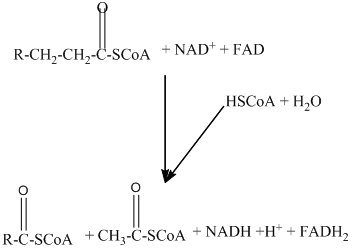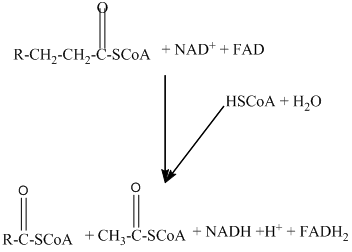
Concept explainers
(a)
Interpretation:
The number of acetyl CoA is formed from complete beta-oxidation of the myristic acid, needs to be identified.
Concept Introduction:
Beta − oxidation of fatty acids involves four series of reactions. In this reaction, the long-chain fatty acid is degraded into many two-carbon unit's acetyl CoA.

The number of acetyl CoA molecules formed, and the number of time beta-oxidation occur can be determined by using the number of carbon atoms present in the fatty acid.
(b)
Interpretation:
The number of cycles of beta-oxidation is required for complete oxidation needs to be identified.
Concept Introduction:
Beta − oxidation of fatty acids involves four series of reactions. In this reaction, the long-chain fatty acid is degraded into many two-carbon unit's acetyl CoA.

The number of acetyl CoA molecules formed, and the number of time beta-oxidation occurs can be determined by using the number of carbon atoms present in the fatty acid.
Want to see the full answer?
Check out a sample textbook solution
Chapter 24 Solutions
EBK GENERAL, ORGANIC, & BIOLOGICAL CHEM
 Introduction to General, Organic and BiochemistryChemistryISBN:9781285869759Author:Frederick A. Bettelheim, William H. Brown, Mary K. Campbell, Shawn O. Farrell, Omar TorresPublisher:Cengage Learning
Introduction to General, Organic and BiochemistryChemistryISBN:9781285869759Author:Frederick A. Bettelheim, William H. Brown, Mary K. Campbell, Shawn O. Farrell, Omar TorresPublisher:Cengage Learning Chemistry for Today: General, Organic, and Bioche...ChemistryISBN:9781305960060Author:Spencer L. Seager, Michael R. Slabaugh, Maren S. HansenPublisher:Cengage Learning
Chemistry for Today: General, Organic, and Bioche...ChemistryISBN:9781305960060Author:Spencer L. Seager, Michael R. Slabaugh, Maren S. HansenPublisher:Cengage Learning General, Organic, and Biological ChemistryChemistryISBN:9781285853918Author:H. Stephen StokerPublisher:Cengage Learning
General, Organic, and Biological ChemistryChemistryISBN:9781285853918Author:H. Stephen StokerPublisher:Cengage Learning Organic And Biological ChemistryChemistryISBN:9781305081079Author:STOKER, H. Stephen (howard Stephen)Publisher:Cengage Learning,
Organic And Biological ChemistryChemistryISBN:9781305081079Author:STOKER, H. Stephen (howard Stephen)Publisher:Cengage Learning,



